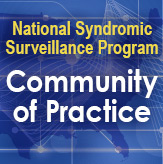Technical Updates
Updated July 20, 2023

Patching Schedule
- July 18: NSSP vendor patches (Testing and Development) 12:00–8:00 AM ET
- July 20: NSSP vendor patches (Onboarding and Production) 12:00–8:00 AM ET
- August 15: NSSP vendor patches (Testing and Development) 12:00–8:00 AM ET
- August 17: NSSP vendor patches (Onboarding and Production) 12:00–8:00 AM ET
Mortality Data
Onboarding of mortality data can be fast. To add the mortality data source for your site, please contact nssp@cdc.gov. Commonly asked questions about mortality data are posted on the NSSP website. An NSSP article describes the routing of mortality data. There’s also a slack channel: #Mortality-data.
Onboarding
The onboarding team hosted the most recent BioSense Platform Data Validation Call on June 7, 2023, at 3:00 PM ET. During these calls, the onboarding team conducts an open forum to answer questions, discusses concerns, and shares tips and resources. Here are a few of the questions raised during the June call:
Q Why aren’t the onboarding facilities displayed in Stage-ESSENCE?
A While the Access & Management Center (AMC) team works on a permanent fix, here’s a workaround:
- In the AMC Master Facility Table, go to the facility’s page.
- Confirm that the facility status is Onboarding and Complete.
- Click Submit to resave the entry.
The facility and its data should be available in Stage-ESSENCE shortly (~10–15 minutes).

BioSense Platform
Data Validation Call:
August 2, 2023, 3:00 PM ET
To receive an invite, select “Onboarding Communications” in your AMC User Profile, or email a request to nssp@cdc.gov.
Q Why aren’t the onboarding facilities displayed on the DQ Dashboard?
A The facilities in the DQ Dashboard are updated once a week. If more than a week has passed and you don’t see the facility but are certain data have been received, please submit an NSSP Service Desk ticket.
Q How do I get access to Posit (RStudio)?
A Due to licensing limitations, NSSP has a limited number of Posit (RStudio) licenses available. As a site administrator, if you or someone in your site requires access to Posit (RStudio), go into their AMC User Profile and check the box for RStudio to request a seat (license). That will send a request to the AMC admins to review and grant the access if there are seats available. Please note: Licensed user accounts are reviewed every 90 days. Users who have not used their Posit (RStudio) accounts within the past 90 days may be removed and will need to request access to be restored.
Q How to Respond to Status of “Pending Site Review”
A The onboarding team recently asked that site administrators check their MFT for facilities with a Review Status of “Pending Site Review.” The reason for this review is that a site administrator or MFT Edit User might have requested that the facility status be updated to Active and, following a review, the NSSP onboarding team declined the activation request.
The only way to clear this status is for a site administrator or MFT Edit User to click Cancel Requested Changes to revert the facility entry to its previous status before the activation request was made. If you’re a site administrator or MFT Edit User, please review your site’s MFT Review Status column for facilities with a Review Status of “Pending Site Review,” and then click Cancel Requested Changes.
For information on Facility Status, Review Status, and how these may affect a facility’s data flow, check out the article “Does Active Really Mean Active?” on the NSSP onboarding webpage. Several other articles describe scenarios that generally need onboarding outreach: “90-Day Inactivation Follow Up,” “Production Exceptions,” and “Moving Data into Production.”
Resources discussed on the call:
NSSP Onboarding
https://www.cdc.gov/nssp/biosense/onboarding.html
https://www.cdc.gov/nssp/biosense/Does_Active_Really_Mean_Active.html
https://www.cdc.gov/nssp/news/2021/10-october/technical-updates.html#onboarding_outreach
https://www.cdc.gov/nssp/news/2021/12-december/technical-updates.html#anchor_1638891310388
https://www.cdc.gov/nssp/news/2021/11-november/technical-updates.html#onboarding_outreach
NSSP Community of Practice
https://nsspcommunityofpractice.org/
https://nsspcommunityofpractice.org/join-participate-and-get-involved/
Access CoP resources and sign up for monthly calls, including the ESSENCE User Group and Data Quality Subcommittee. Register for access to the Slack community.
NSSP CoP Knowledge Repository
https://knowledgerepository.syndromicsurveillance.org/
CDC Promoting Interoperability Resources
https://www.cdc.gov/datainteroperability/index.html
Promoting Interoperability Resources from the Community
https://www.cms.gov/files/document/12-ipps-fy-2022-syndromic-surveillance-reporting.pdf
https://www.cms.gov/files/document/infographic-pi-program-vs-mips-pi-perf-category.pdf
Several new site administrators requested information and resources for Promoting Interoperability. The above resources were provided by other site administrators, including Steve Eichner (Steve.Eichner@dshs.texas.gov). You may contact Steve for information on and support with Promoting Interoperability.
If you’re interested in joining the next Data Validation call, please email the NSSP mailbox (nssp@cdc.gov) or create an NSSP Service Desk ticket.
NSSP Introduces pynssp, an Alternative to the Rnssp Package for Python Users
 External Link Icon
External Link IconPython offers a high-level, object-oriented programming environment well-suited for data analysis.
We’re excited to announce the release of pynssp v0.1.0.
When we introduced the Rnssp package, it was met with mixed reviews. The R programmers were ecstatic. But programmers who use Python, which predates R and offers more speed and functionality, asked that NSSP provide the same functionality to them. So, that’s what we’ve done. We’ve also expanded the Posit Workbench environment (formerly, R Workbench) to support Python as a data analysis/science language, too, via Jupyter Notebooks and JupyterLab.
If you’re a proponent of Python, we think you’ll be pleased with pynssp v0.1.0, a Python counterpart to the Rnssp R package. Python offers various libraries not available in R that certain users might need. Python and R are equally easy to obtain and install. Both pynssp and Rnssp have many similarities, few differences, and provide the same core functionalities.
The pynssp Python package can be installed via pip by running the following command in your terminal:
pip install pynssp
Source code and official online documentation for the new pynssp package are publicly available. The CDCGOV Github platform is CDC’s GitHub organization for collaborating on open-source projects; maintaining source codes; and continuously testing, integrating, and deploying software products. The pynssp package is also available on the Python Package Index (PyPI) , which makes installation easy for Python users.
Publication Updates
- Part 7 of the series on how to write ESSENCE free-text queries is available on the NSSP website. See Tips and Training, “Part 7. Additional Tips: ISBLANK and ISNULL.” Author Zach Stein explains how queries work when some fields are BLANK and others NULL. Articles in this series include Wildcards, Underscores and Brackets, Inclusionary Terms, and Exclusion Terms and Parentheses.
- Python users can find the recently released pynssp package and its accompanying documentation on the Python Package Index (PyPI) and related GitHub pages.
